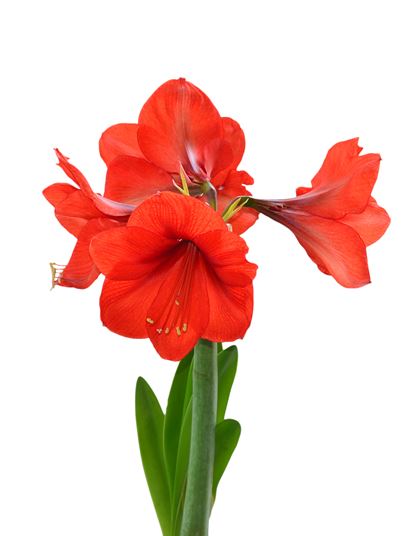
HIPPEASTRUM
Hippeastrum cultivars
hip-PEA-strum
Description
A tropical bulb with large, trumpet-shaped, lily-like blossoms borne atop a thick, leafless stem 14–28" (35.5–70 cm) tall. Blossom size and number depend upon the cultivar and bulb size; two, four or six blooms are possible, though most varieties will have four. Blooms may be nearly 9" (22 cm) long and 4–6" (10–15 cm) in diameter. They have no fragrance and are extremely ethylene sensitive. Flower buds grow with their noses pointing heavenward, but turn into trumpet-sounding position by the time they bloom.
Colors: White, pink, red, orange and salmon. Colors may be solid or red-and-white striped.
Special Care
Hollow stems tend to curl. Keep in shallow water, wrap tape or rubber band around cut end or work the curling into your design. Use a bamboo stake inside the stalk to support the heavy blooms.
Flowers are chill sensitive; cold will discolor blossoms. Store at about 50°F (10°C). Blooms bruise easily, so avoid handling them directly.
Display in a cool, bright spot and hydrate with tepid water. To prevent pollen stains, anthers may be removed without affecting vase life.
Fun Facts:
Amaryllis, the common name for Hippeastrum, means sparkling in Greek. The flower may have gotten its name from a Greek myth of a shepherdess with that name. To prove her love to an uncaring gardener, Amaryllis thrust a golder arrow into her own heart, trailing blood as she walked past his door. After a month of repeating this stunt daily, huge red flowers rose from the blood she had spilled, which snapped the gardener out of his scorn and healed Amaryllis’ heart. The flowers still bear her name.
Researchers have found a compound in Hippeastrum and its relatives which shows promise as a treatment for Alzheimer’s disease.
In nature, Hippeastrum blooms in the spring or summer along with all the other bulbs. Floral suppliers refrigerate the bulbs in the fall to simulate winter, which forces (tricks) them into blooming out of season, during the winter holidays.
In the wild, Hippeastrum is pollinated by moths and carpenter bees.
Hippeastrum bulbs are propagated by “daughter” bulbs which grow from the larger “mother” bulb. Growing a daughter bulb to productive size takes between three to five years.
A well-tended Hippeastrum bulb can live for 75 years!
Like many plants in the lily family, Hippeastrum contains alkaloids which are toxic to pets (and humans!), so the plants and cut flowers must be placed away from the reach of curious household creatures.
Use the hollow stems’ tendency to curl to your advantage in designs. Make strategic slits to make the stems curl like scrolls or wrap them around objects. You can even suspend them upside down and use the hollow stem as a vase for another flower! As long as they receive ample water, the stems curling won’t shorten the flower’s life at all.
A common name for Hippeastrum is “naked lady,” because it blooms on a bare stalk and grows leaves later.
The name Hippeastrum is a combination of the Greek words for “horse” and “star,” comparing the silhouette of the developing buds protruding from between the stiff leaves to the shape of a horse’s head.
A member of the Amaryllidaceae family, Hippeastrum is related to onions, and Nerine and Narcissus plants.
Common Name
Amaryllis
Botanical Name
Hippeastrum cultivars
Pronunciation
hip-PEA-strum
Origin

Seasonal availability
Vase Life
7 - 10 days
Fragrant
No
Ethylene
Sensitive
Yes
Dryable
No
Language of Flowers Meaning
Hippeastrum flowers are used to symbolize love and beauty, along with hope and determination.